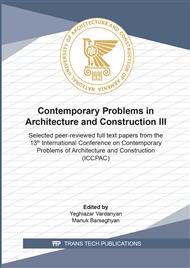p.1
p.7
p.17
p.25
p.31
p.39
p.47
p.53
p.59
The Influence of Cement Grain Structure on Physical and Mechanical Properties of Cement
Abstract:
The paper presents the study of morphological characteristics of cement particles and reveals the influence of the structure of the cement grain composition on the physical and mechanical properties of cement. The following portland cements produced by “Hrazdan Cement Corporation” LLC, which have 52,5 MPa and 42,5 MPa compressive strength limit and hydraulic additives up to 20% and over 20% have been used for the experiment: CEM II/ A-P 42,5N, CEM II/ B-P 42,5N, CEM II/A-Q 42,5N, CEM II/B-Q, CEM II/A-L 42,5N, CEM II/B-L 42,5N, CEM II/A-M 42,5N, CEM II/B-M, CEM III/A-S 42,5N and CEM III/B-S 42,5N. Grain distribution in all the samples has been studied using a CILAS laser analyzer. Microscopic analysis of all the fractions has been carried out with the help of James Swift optical microscope. The given grain compositions have undergone chemical analysis in compliance with the requirements of interstate ISO 5382-2019 and ASTM C114-18 standards. Experimental studies and analyses show that the cements with microsilica have the highest value of water-cement ratio-W/C = 0.7, the highest by volume compression are the cements with volcanic slag-4 mm, the beginning of the bonding period is the longest in case of limestone cements - t = 140 minutes, followed by microsilica cements, and in third place there are artificial slag cements, the results of which are as follows: 130; 124 minutes. The summarized data show that microsilica cements have the highest compressive strength limit among the cements having the same percentage of additives-48.87 MPa.
Info:
Periodical:
Pages:
31-37
Citation:
Online since:
January 2022
Price:
Сopyright:
© 2022 Trans Tech Publications Ltd. All Rights Reserved
Share:
Citation:


